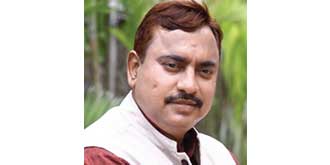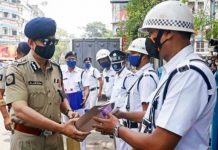
Though policing has been one of the male bastions for decades, women have started making forays into this exclusive club in recent times. From the execution of its male-centric policies, this vital pillar of democracy has been heavily influenced by military think-tanks. They have adopted a military model for training, dress codes, promotional structure, work culture and informal cultural ethos.
Culturally ascribed and stereotyped masculine traits such as boldness, risk-taking, aggression, competitiveness, assertiveness, commanding voice, the assertion of autonomy and authoritative expertise are regarded as quintessential attributes to be successful in this profession.
The ‘cult of womanhood’1 emphasising the role of women as wives, mothers, nurturing families, and submissiveness dominate the imagination and consciousness of women generation after generation as a result of gender socialisation. The masculine attributes are anti-ethical to the feminine qualities women acquire due to cultural, ideological and psychological gender conditioning. But women have started entering the institution of police considered to be a male stronghold world-wide. Currently, the percentage of women compared to the total strength of police is 7.28.2
To look into the historical integration of women in Kolkata Police, archival records and manuscripts available in the West Bengal State Archives, Writer’s Building, and the Kolkata Police Museum, have been consulted.The induction and gradual assimilation of women in the Kolkata Police may be divided into four stages: 1949-1980, 1980-1990, 1990- 2000 and 2000-2019.
1949-1980: Formal entry of women into the Calcutta Police3
In 1948, the Ministry of Relief and Rehabilitation, Government of India, New Delhi, requested the provincial government to make use of women officers to enquire about the pardanashin ladies who desired to travel from India to Pakistan. The underlying assumption behind the recruitment of women police personnel was to prevent refugee women in distress from having to come into contact with men outside the family.
Thus a drive for inducting women in the Calcutta Police was launched at that time. A copy of a letter from Shri P. K. Basu, JP., deputy commissioner of police, Special Branch, to L. A. D`Costa, Esq., B. E. M., Asstt. Secy. to the Government of West Bengal, Home (Political Department) states, “I would suggest that the Special Branch be given the service of a lady officer with the status of a Sub-Inspector to make inquiries about PardaNashin ladies preliminary to the issue of No Objection Certificates’.4 A letter (dated 14 June, 1949) by the assistant secretary to the secretary to the Government of India, Ministry of Relief and Rehabilitation, New Delhi, states that ‘with reference to your letter no 13939/48 N*I dated 6.1.49 on the above subject, I am directed to say that the services of a lady Sub-Inspector will be made available for the Special Branch from the existing staff on the requisition and that no extra expenditure will be required on this account’.5 A women’s section of Calcutta Police was set up on June 1, 1949.6 Nine women sub-inspectors and twenty-three assistant subinspectors were recruited for the Calcutta Police, for the first time in 1949, marking the formal entry of women into the Calcutta Police.7 They received residential training at 8 Theatre Road. Mrs. Edward (the superintendent’s wife) was the matron-in-charge during the training period. Married women were given a day-off on Saturday. They had to return to the barracks by Sunday evening. Except for rifle training, the indoor and outdoor training for men and women police personnel remained identical.8 On June 12, 1949, women police were out on public duty for the first time during elections.9 The sixth company consisting of women police officers (under the command of Mr. Williams, assistant commissioner of security control) for the first time participated at the Annual Police Parade on September 19, 1949 at the Police Training School.10 Initially, they were kept as a reserve at Lalbazar, the Calcutta Police Headquarters. To control refugee demonstrations on the streets of Kolkata or any other law-and-order problems where women agitators were involved, women police were assigned duty.11 They mostly performed non-field administrative and clerical duties. The sphere of work remained restricted to women and children only. The official rate of crime committed by women as well as those committed against them was negligible. As a result, no effort was made by the policy planners to recruit women police in large numbers. Only when required, they were taken to the police station where they had to record the statement of woman victims or were used for frisking women offenders. But on a regular basis, they were never posted at the police stations. Inside the Kolkata Police Museum, there is a photograph of the then Chief Minister Shri P.C. Sen, receiving a salute from the women police contingent in the early sixties. The women police contingent was wearing sari.12 Their uniform – sari symbolised the caring role performed by them. At that time women police personnel were stationed at the police headquarters (in Lalbazar). In the late 1940s or even in the 1950s, men police personnel were used for searching houses.13 In the 1960s, for the first time, a few women sub-inspectors were promoted to the rank of inspector but were to remain posted at the headquarters only.14 As inspectors, women officers received postings to the crime record section of the detective department and press and law section of the Calcutta Police.
During the turbulent times of the Naxal movement in Kolkata, women police personnel mostly performed non-field desk duties. However, no women personnel were deployed to deal with females involved with the Naxal movement.
In 1975, a few women subinspectors and assistant subinspectors were recruited. But they never received postings at the police stations.
1980-1990: ‘Formalisation’ of women in Kolkata Police15
Till the late 1970s/early 1980s, it was men police who would perform the normal police duties of interrogation, investigation, making arrests and working at the police stations. Women had a token presence in the Calcutta Police till the mid-1980s. The concept of utilising women officers in normal police work and treating them at par with men had not developed till then. The new women’s movement in the late 1970s and early 1980s and human rights activities helped to create awareness in society. The trend started changing from the late 1980s/early 1990s. New legal provisions were introduced (such as the Criminal Law Amendment of 1983) and it became mandatory to recruit and deploy women police when arrest orders were issued for women accused or offenders.
This decade witnessed formalisation and systematic entry of women into the Calcutta Police. The year 1982 was a landmark year for women in the Calcutta Police. Kanika Banerjee, a sub-inspector of police, special branch, received the police medal for meritorious service along with few male officers on the occasion of Republic Day.16 In April 1982, for the first time, one of the five posts of inspector of police was upgraded to the post of assistant commissioner of police in the women police wing of Calcutta Police.17 Mira Sarkar became the first assistant commissioner of police in the women police wing of the Calcutta Police.18 On 1 March, 1986, the temporary posts of sub-inspector were converted into permanent ones.19 In September 1986, 50 permanent posts of women police constables were sanctioned and for the first time in 1986, women constables were recruited into the Calcutta Police.20 In order to control the increasing rate of crime committed against women, the state government on 2 December 1987 considered the question of setting up for each Police Division in Calcutta, an Advisory Committee for assisting in the investigation and prevention of crime against women. The function of the committee was to periodically assess the state of crime against women in the area, to find out the progress of the investigation of major cases relating to women by the police and to suggest measures to the local authorities for prevention of crime against women in the light of the particular needs of the area.21 In 1988, the detective department of the Calcutta Police launched the women’s grievance cell, which deals with cases related to atrocities committed upon women within the jurisdiction of the Calcutta Police. The work of the officer-in-charge of the women’s grievance cell ranges from the investigation of cases (of violence against women) to counselling.
For the first time, a woman IPS officer, Mamta Anurag was posted as the deputy commissioner II (special branch) in the Calcutta Police on 8 March, 1990.22 Henceforth, women IPS officers have been posted in the Kolkata Police. From 21 August, 1990, a formal uniform of trousers and shirt was introduced for women in the Calcutta Police.23 The order by the commissioner of police states: Women police personnel, deployed on law and order and other outdoor duties shall perform the duties in working uniform comprising of white slacks, white bush shirts/white shirts, belt, black shoes and helmet. They will also carry half lathi. The Assistant Commissioner, Women Police, will, however, wear khaki uniform, brown belt and brown shoes.24 For a brief period in the early 1990s, women police personnel were assigned the duty of controlling traffic in the streets of Kolkata. But some women complained that they were harassed by the passerby. As a result, this practice of deploying women for traffic duty was stopped.25
1990-2010: Induction of women into the mainstream of Kolkata Police
In present times, the capabilities of women police personnel are being ‘tested’ by the police department by assigning duties where they have not been posted before. They are being assigned field postings and also at police stations. In 2001, Deboshree Chatterjee became the first woman in the Calcutta Police to be appointed the additional officer-in-charge of the Hare Street police station. In 2010, she became the first woman to be posted as the officer-incharge of the North Port police station.26 Damayanti Sen, IPS, became the first woman IPS officer to receive field postings as the deputy commissioner of north and northern suburban division and central division in Kolkata Police. She became the first woman in the history of the Kolkata Police to be appointed deputy commissioner of the detective department of the Kolkata Police. For a considerable period of time, she served as joint commissioner (crime) of the Kolkata Police.27
2011-2019 : Socio-legal changes and their impact on the recruitment of women in the Kolkata Police
On 16 December, 2012, a paramedical student accompanied by her male friend was gang-raped in a moving bus in Delhi. The incident caused a huge public furore in India. The Government of India in a bid to control this unprecedented anger among people, appointed a committee headed by late Justice J. S. Verma to review the existing laws on offence against women and drafted a blueprint on the safety and security of women. The Criminal Law (Amendment) Act, 2013 was enacted. Acid attack, stalking, voyeurism etc were included within the purview of a punishable offence under Indian Penal Code. The new legal provisions especially in case of sexual offences, trafficking of women and children has made it mandatory to record the statement of women victims and abused by a women police officer. All these socio-legal changes necessitated increase in the recruitment of women in police.
After the Trinamool Congress government came to power in the state in 2011, one post of deputy commissioner (women police) has been created in Kolkata Police.28 Smt. Parbati Pal was posted as the first deputy commissioner (women police) in Kolkata Police. She served on that post from November 20, 2012 to May 31, 2014.29 On August 6, 2014, Smt. Deboshree Chatterjee became the second woman to be promoted as the deputy commissioner (women police).30
To deal with the increasing law-and-order problem, women have been deployed in the Rapid Action Force (RAF) unit of the Kolkata Police.31 Women personnel have been deployed at the Rapid City Patrol (RCP) which is stationed at night to respond to any woman related crimes. They are seen patrolling the city at different locations throughout the day and also at night. The RCP works in two shifts. At night, there is an additional constable while during the day there is one sub-inspector and one constable along with a male driver.32 Though women personnel are kept on standby at police stations, the organisation is seriously thinking of inducting few women police personnel on police kiosks to help out women in distress.33 The Kolkata Police has revived a proposal to raise its first all-woman battalion. The proposed battalion will be part of the Kolkata Armed Police.34 But at present (March 2017) no woman battalion is present in Kolkata Police. In recent times, there has been an increase in the rate of crime committed against women in West Bengal. In a bid to curb the rise in crime against women, the present government in West Bengal has decided to take a few innovative steps, which include increasing the recruitment of women in the police force. In the Kolkata Police, the government intends to recruit 2,600 women or 10 percent of the existing strength of the Kolkata Police.35 It is hoped that political patronage will help improve the position of women police in West Bengal, as has happened in Tamil Nadu. Eight women police stations under the jurisdiction of Kolkata Police have been made operational. In the first phase Watgunge, Tollygunge, Patuli, and Amherst Street women police stations were set up on July 27, 2016. Four other women police stations – Taltala, Behala, Karaya, and Ultadanga were set up within the next six months. Senior women inspectors are been appointed as the officer in-charge of these women police stations. Such women inspectors and their team of women police personnel are engaged in all policing activities where women are the perpetrators as well as victims of crime. Besides registering various cases of crime against women, these police stations also give counselling to aggrieved couples to men their family ties. Women police stations register and investigate cases under the Protection of Children from Sexual Offences Act, 2012, for delivering justice to child victims. Aiming to combat and prevent crimes such as molestation, eve teasing, and make public places safer for women, the Kolkata Police launched a special all women patrolling team called “The Winners”. The primary job of these lady officers will be to assist their male counterpart in helping women registering complaints of molestation or eve-teasing on city streets.36
In Kolkata Police, women have made an ‘entry’ into the police force. Women were assigned a ‘separate restricted sphere of work’. They were assigned a ‘peripheral’ and ‘specialist’ role of dealing with women and children. The ‘takeoff’ has taken place as seen in an increase in the recruitment of women in Kolkata Police. But the ‘tip-over’ from being a small minority of officers to a more equal representation has not yet been reached. On the part of the police organisation, it is necessary to realistically prepare the ground for women police to emerge by modernising their training and improving their working conditions. There is a scope of improvement in the infrastructural facilities of the police organisation.
Notes and References :
1. Welter, Barbara., ‘The Cult of True Womanhood 18201860’, in Barbara Welter, Divinity Communications: The American Woman in the 19th Century, Ohio University Press, Atheno, 1976, pp.21-41.
2. Data on Police organization in India as on 1st January 2017, Bureau of Police Research and Development, Ministry of Home Affairs, Government of India, p. 147.
3. When the former Commissioner of Police, Kolkata Police, was interviewed on 22 April 2010 he said in 2003-04 Calcutta Police was renamed Kolkata Police. Whereas another senior police officer in Kolkata Police, when interviewed on 18th May 2012 said that on 21st January 2001, Calcutta Police was renamed Kolkata Police. I have not been able to find out which is the case.
4. Government of West Bengal, Home Department, Police Branch. File No. P14 M-14/49.
5. Government of West Bengal, Home Department, Police Branch. Issue no. 2163 Pl. Date of Issue:15.06.49.
6. As mentioned in the Kolkata Police Museum, Kolkata. Calcutta Police Gazette, 15th June 1949.
7. Calcutta Police Gazette, 15th June 1949.
8. Interview with Lila Chowdhury, former assistant commissioner of police, women police, Kolkata Police.
9. As mentioned in the Kolkata Police Museum on 4th November 2016.
10. As mentioned in the Kolkata Police Museum on 4th November 2016.
11. Interview with Mrs. Lila Chowdhury, former assistant commissioner of police, Kolkata Police.
12. As mentioned in the Kolkata Police Museum on 4th November 2016
13. When the former Commissioner of Police, Kolkata Police, was interviewed on 22nd April 2010 he said women were never used for searching houses. Whereas another senior police officer in Kolkata Police, when interviewed on 8th November 2008 had said at times women were used for searching houses. I am not been able to find out which is the case.
14 Calcutta Police Gazette, 15th March 1960. Also see Calcutta Police Gazette, 23rd March 1960.
15. When the former Commissioner of Police, Kolkata Police, was interviewed on 22 April 2010 he said in 2003-04 Calcutta Police was renamed Kolkata Police. Whereas another senior police officer in Kolkata Police, when interviewed on 18th May 2012 said on 21st January 2001 Calcutta Police was renamed Kolkata Police. I have not been able to find out which is the case.
16. Calcutta Police Gazette, 4th February 1982.
17. Letter from Shri. N. C. Chakraborty, deputy secretary to the Government of West Bengal to the commissioner of police, Calcutta.
18.Calcutta Police Gazette, 14th July 1982.
19. Calcutta Police Gazette, 7th April 1986.
20.Calcutta Police Gazette, 11th September 1986.
21.Calcutta Police Gazette, 2nd December 1987.
22.Calcutta Police Gazette, 9th March 1990.
23. Calcutta Police Gazette, 21st August 1990.
24.Calcutta Police Gazette, C. O. No. 698 dated 20-08-90.
25. As told to the author by women police personnel, when interviewed at the police headquarter, Lalbazar from 2007 to 2012.
26. ‘Deboshree Chatterjee first woman to head a police station in Kolkata’, The Statesman, 16th November 2010
27. ‘Kolkata gets its first woman super-sleuth’, The Times of India, 8th October 2009.
28.‘City faces shortage of women cops’, The Times of India, 17th December 2013.
29. Officer of the deputy commissioner (Women Police), Kolkata Police.
30. Ibid.
31. Interview with the additional commissioner of police, Kolkata Police in 2011.
32. ‘Women in Uniform. RCP: Donning a new avatar. Its time to change: Proper training and motivation bring out the best in women police officers’, The Kolkata Protector, Vol.4, Issue 6. 2014, pp.12-13.
33. ‘City faces a shortage of women cops’, The Times of India, 17th December 2013.
34. ‘Lal Bazar Ladies’ Special’, The Telegraph, 4th June 2011.
35. The Telegraph, 4th June 2011.
36. The Kolkata Protector, July-August 2018, p.75.













